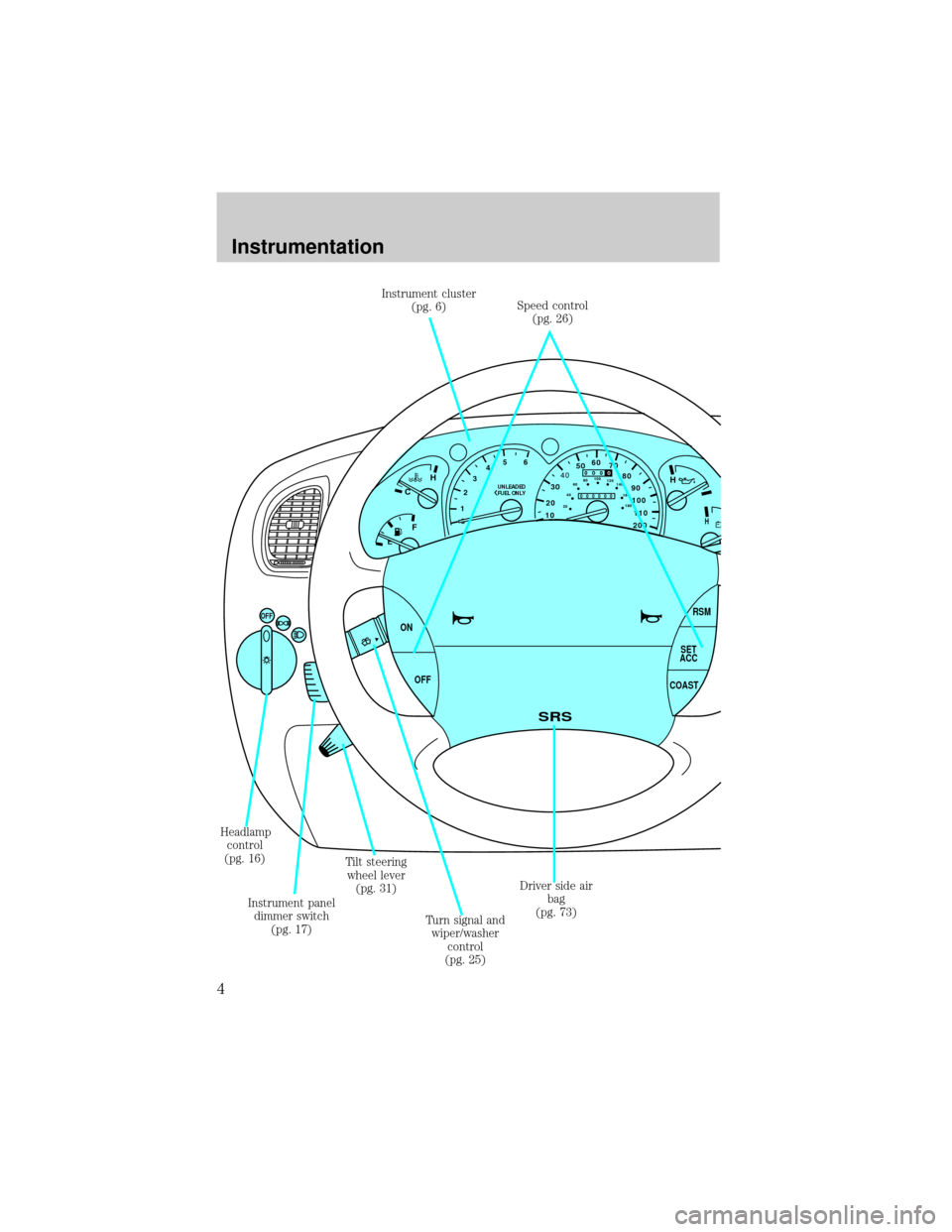steering wheel Mercury Mountaineer 1998 Owner's Manuals
[x] Cancel search | Manufacturer: MERCURY, Model Year: 1998, Model line: Mountaineer, Model: Mercury Mountaineer 1998Pages: 216, PDF Size: 1.72 MB
Page 4 of 216

012345
6
H
C
F
E
OFF
20
1030405060
70
80
90
110
200000000
oooo
10020406080100
120
140
160
180
UNLEADED
FUEL ONLY
RSM
SET
ACC
COAST OFF ON
SRS
H
H
Instrument cluster
(pg. 6)Speed control
(pg. 26)
Driver side air
bag
(pg. 73) Headlamp
control
(pg. 16)
Instrument panel
dimmer switch
(pg. 17)Tilt steering
wheel lever
(pg. 31)
Turn signal and
wiper/washer
control
(pg. 25)
Instrumentation
4
Page 31 of 216

TILT STEERING
Pull the steering control toward
you to move the steering wheel up
or down. Hold the control while
adjusting the wheel to the desired
position, then release the control
to lock the steering wheel in
position.
Never adjust the steering
wheel when the vehicle is
moving.
HAZARD FLASHER
For information on the hazard
flasher control, refer toHazard
lights controlin theRoadside
emergencieschapter.
Controls and features
31
Page 75 of 216

Do not place objects or
mount equipment on or
near the air bag cover on the
steering wheel or in front seat
areas that may come into contact
with a deploying air bag. Failure
to follow this instruction may
increase the risk of personal
injury in the event of a collision.
Do not attempt to service,
repair, or modify the Air
Bag Supplemental Restraint
System or its fuses. See your
Ford or Lincoln-Mercury dealer.
Children and air bags
For additional important safety
information, read all information
on safety restraints in this guide.
Children should always wear their
safety belts. Failure to follow these
instructions may increase the risk
of injury in a collision.
Air bag can kill or injure a
child in a child seat. If you
must use a forward-facing child
seat in the front seat, move seat
all the way back.
Seating and safety restraints
75
Page 101 of 216

shudder while braking, felt mainly
in the steering wheel, the vehicle
most likely needs service.
The ABS operates by detecting the
onset of wheel lock up during
brake applications and
compensating for this tendency.
The front wheels are prevented
from locking even when the brakes
are firmly applied. The
accompanying illustration depicts
the advantage of an ABS equipped
vehicle (on bottom) to a non-ABS
equipped vehicle (on top) during
hard braking.
ABS warning lamp
The
ABSwarning lamp in the
instrument cluster illuminates for
about five seconds when starting
the vehicle. If an ABS fault is
detected, the light will remain on
and your vehicle should be
serviced as soon as possible.
Normal braking is still effective
unless the BRAKE warning lamp is
also illuminated.
Using ABS
²In an emergency or when
maximum efficiency from the
ABS is required, apply
continuous full force on the
brake. The ABS will be activated
immediately, thus allowing you
to retain full steering control of
your vehicle and, providing
!
BRAKE
Driving
101
Page 114 of 216

Shifting from 4WD LOW to 4WD
AUTO or 4WD HIGH
1. Bring the vehicle to a stop.
2. Depress the brake.
3. Place the gearshift in N
(Neutral) (automatic transmission)
or depress the clutch (manual
transmission).
4. Move the 4WD control to the
4WD AUTO or 4WD HIGH position.
Driving off-road with 4WD
Your vehicle is specially equipped
for driving on sand, snow, mud and
rough terrain and has operating
characteristics that are somewhat
different from conventional
vehicles, both on and off the road.
Maintain steering wheel control at
all times, especially in rough
terrain. Since sudden changes in
terrain can result in abrupt
steering wheel motion, make sure
you grip the steering wheel from
the outside. Do not grip the
spokes.
Drive cautiously to avoid vehicle
damage from concealed objects
such as rocks and stumps.
You should either know the terrain
or examine maps of the area
before driving. Map out your route
before driving in the area. For
more information on driving
off-road, read the ªFour Wheelingº
supplement in your owner's
portfolio.HIGH
LOW AUTO
Driving
114
Page 119 of 216

Driving off-road with AWD
Your vehicle is specially equipped
for driving on sand, snow, mud and
rough terrain and has operating
characteristics that are somewhat
different from conventional
vehicles, both on and off the road.
Maintain steering wheel control at
all times, especially in rough
terrain. Since sudden changes in
terrain can result in abrupt
steering wheel motion, make sure
you grip the steering wheel from
the outside. Do not grip the
spokes.
Drive cautiously to avoid vehicle
damage from concealed objects
such as rocks and stumps.
You should either know the terrain
or examine maps of the area
before driving. Map out your route
before driving in the area. For
more information on driving
off-road, read the ªFour Wheelingº
supplement in your owner's
portfolio.
If your vehicle gets stuck
If the vehicle is stuck, shift the
transmission in a steady motion
between forward and reverse
gears. Allow the transmission to
engage, then press lightly on the
accelerator.
Do not rock the vehicle for
more than a few minutes. The
transmission and tires may be
damaged or the engine can
overheat.
Driving
119
Page 144 of 216

Fuse/Relay
LocationFuse Amp
RatingDescription
PCM Power
RelayÐ PCM Power Relay
Fuel Pump Relay Ð Fuel Pump Relay
Horn Relay Ð Horn Relay
Washer Pump
RelayÐ Washer Pump Relay
Fog Lamp Relay Ð Fog Lamp Relay
Starter Relay Ð Starter Relay
Blower Motor
RelayÐ Blower Motor Relay
1 Resistor Fuse [7ca]
2 Diode Anti-Lock Brakes Indicator
3 Diode Electronic Engine Controls
* Mini Fuses ** Maxi Fuses
15.0L Engines Only
CHANGING THE TIRES
If you get a flat tire while driving,
do not apply the brake heavily.
Instead, gradually decrease your
speed. Hold the steering wheel
firmly and slowly move to a safe
place on the side of the road.
Spare tire information
Your vehicle is equipped with a
spare tire that may be used as a
spare or a regular tire. The spare
tire is not equipped with wheel
trim. The wheel trim from the
original wheel/tire may be used on
the spare.
If your vehicle is equipped with
4WD or AWD, a spare tire of a
different size than the road
tires should not be used. Such
Roadside emergencies
144
Page 168 of 216

²4.0L SOHC engine
²5.0L engine
1. Start the engine and let it run
until it reaches normal operating
temperature (the engine coolant
temperature gauge will be near the
center of the NORMAL band).
2. While the engine idles, turn the
steering wheel left and right
several times.
3. Turn the engine off.
4. Check the fluid level in the
reservoir.
5.If your vehicle is equipped
with a 4.0L SOHC engine or a
5.0L engine,the fluid level should
be between the MIN and MAX
DONOTOVERFILLPOWERSTEERINGFLUID
Maintenance and care
168
Page 214 of 216

improving fuel economy ........134
octane rating ...........................185
quality ......................................186
safety information relating to
automotive fuels .....................183
Fuel gauge ...................................15
Fuel pump shut-off switch .......135
Fuse panels
instrument panel ....................138
power distribution box ...........141
Fuses ...................................136,137
Gauges, Mechanical ....................12
engine coolant temperature
gauge .........................................13
Hazard flashers .........................135
Head restraints ......................62,65
Headlamps ...................................16
daytime running lights .............16
flashing ......................................17
high beam .................................17
Heating ........................................18
High beams
indicator light .............................9
Hood
release lever ............................156
Instrument panel
lighting up panel and interior..17
Jump-starting your
vehicle .................................149,151
attaching cables ......................150
disconnecting cables ..............151
Keyless entry system
autolock .....................................50
keypad .......................................52
locking and unlocking doors ....54
programming entry code ....53,54
Keys
key in ignition chime ...............12
Liftgate ........................................43
Lights, warning and indicator
air bag ..........................................8
anti-lock brakes (ABS) ..............9anti-theft ...................................10
brake ............................................9
charging system ........................10
check engine ............................6,7
cruise indicator .........................11
door ajar ....................................10
fuel reset .....................................8
overdrive off ..............................11
safety belt ...................................8
turn signal indicator ...................9
Load limits
trailer towing ..........................125
Lubricant specifications ...........207
Luggage rack .............................133
Mirrors
cleaning ...................................203
side view mirrors (power) .......41
Moon roof ....................................34
Motorcraft parts ........................204
Odometer .....................................13
Off road driving, 4-wheel
drive ....................................114,119
Overhead console
compass/temperature display ..33
storage compartment ...............33
Panic alarm feature, remote
entry system ................................47
Parking brake ............................102
Power door locks ........................40
Power steering
fluid, checking and adding ....167
Radio (see Electronic sound
systems) ......................................25
Rear window
washer .......................................32
Recreational towing, all wheels
on the ground ...........................133
Refill capacities for fluids ........204
Relays ........................................136
Remote entry system .................46
illuminated entry ......................49
locking/unlocking doors ......46,47
Index
214
Page 215 of 216

replacement/additional
transmitters ...............................49
replacing the batteries .............48
Reporting safety defects ..........212
Safety restraints
automatic locking mode
(retractor) ............................69,70
extension assembly ..................71
for children ...............................78
lap and shoulder belts .............68
maintenance ..............................72
proper use .................................66
warning light and
chime ...............................11,71,72
Safety seats for children
attaching with tether straps ....85
automatic locking mode
(retractor) .................................82
tether anchorage hardware .....85
Seats ............................................62
adjusting the seat, manual .......62
adjusting the seat, power ........63
folding rear seats ......................65
lumbar support .........................64
rear seat access ........................65
Servicing your vehicle ..............154
precautions when servicing ...154
Snowplowing .................................3
Special notice
utility-type vehicles ....................3
Specification chart, lubricants .207
Speed control ..............................26
canceling a set speed ...............29
indicator light ...........................30
resuming a set speed ...............30
tap up/tap down .......................28
turning off .................................26
Speedometer ...............................12
Starting your vehicle ........94,95,97
Storage compartments
overhead storage
compartment .............................33Tachometer
mechanical cluster ...................14
Tilt steering wheel ......................31
Tires ....................................176,179
checking the pressure ............179
replacing ..................................181
rotating ....................................179
snow tires and chains ............182
treadwear ................................177
Traction-lok rear axle ........123,172
Trailer towing ............................127
tips ...........................................132
Transfer case
fluid checking .........................172
Transmission .............................169
automatic
operation .........................104,105,
106,107,108,109,110
fluid, checking and adding
(automatic) .............................169
Trip odometer .............................14
Turn signal
lever ...........................................25
Vehicle dimensions ...................209
Vehicle headlamp aiming
device (VHAD) .........................194
Vehicle Identification Number
(VIN) ..........................................211
Vehicle loading ..........................123
Ventilating your vehicle .............99
Warning chimes .............................6
Windows
power windows, operating .......39
Windshield washer fluid and
wipers
checking and adding fluid .....163
checking and replacing wiper
blades ......................................175
operation ...................................32
Wrecker towing .........................152
Index
215